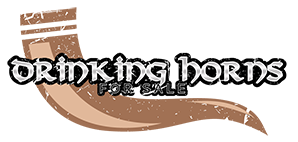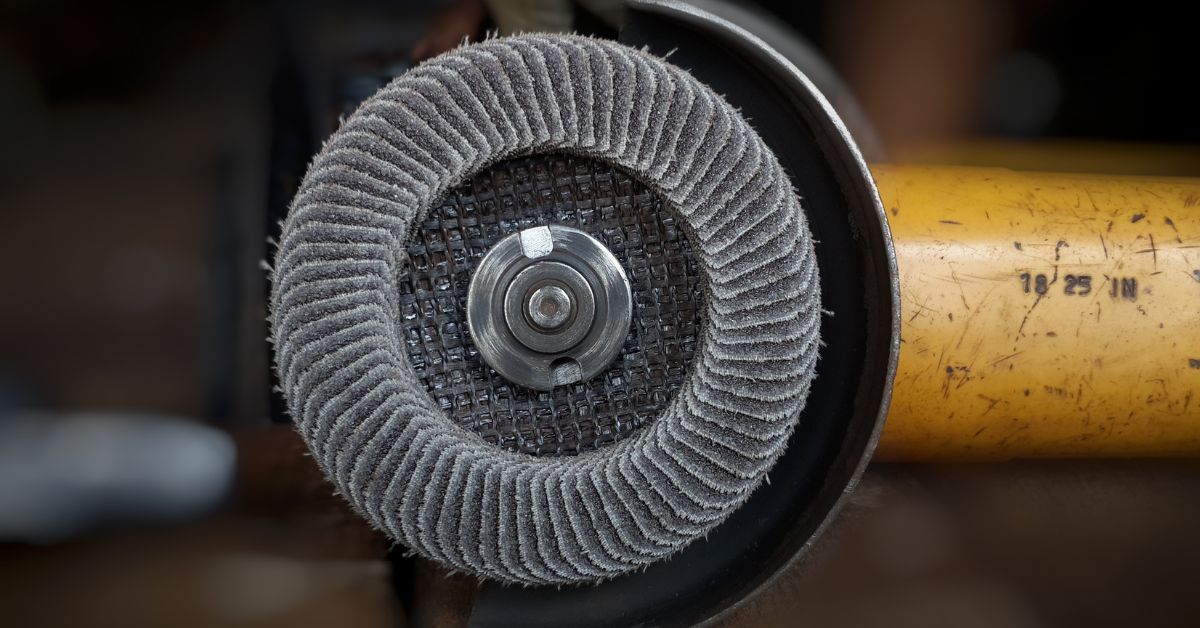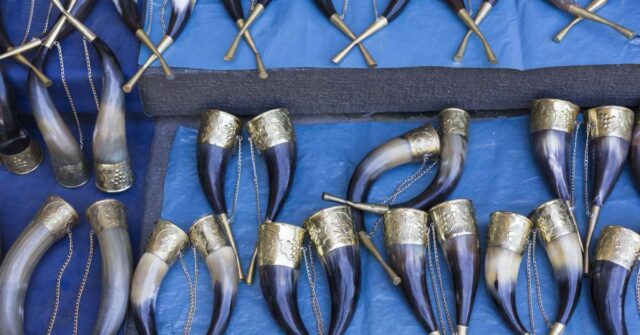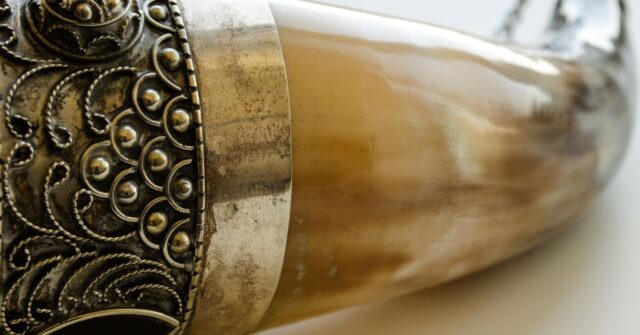Drinking horns, historically significant and visually striking, are crafted using a blend of traditional and modern techniques.
This blog delves into the comprehensive process of crafting these magnificent items, offering insights into the materials, tools, and methods involved.
Introduction
Drinking horns have captivated human imagination for centuries. From ancient ceremonial uses to modern-day collectibles, these artifacts are rich in history and craftsmanship.
The Historical Significance of Drinking Horns
Drinking horns have been used since ancient times, dating back to the Greeks, Romans, and Vikings.
They served not only as practical vessels for consuming beverages but also as symbols of status and culture. In medieval Europe, owning an intricately carved drinking horn was a mark of prestige.
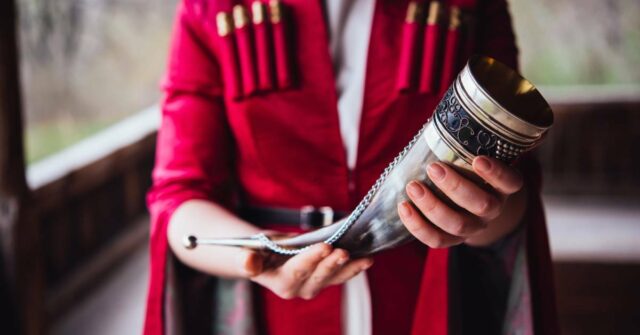
Modern-Day Popularity and Uses
Today, drinking horns are popular among history enthusiasts, reenactors, and collectors. They are used in cultural festivals, historical reenactments, and as unique decorative pieces.
The craftsmanship involved in making these horns continues to evolve, blending ancient techniques with modern innovations.
Materials Used in Drinking Horn Craftsmanship
The choice of materials is crucial in the creation of drinking horns. Different types of horns and supplementary materials influence the final product’s aesthetic and functionality.
Types of Horns
Various types of horns are used in the crafting process, each offering unique properties and challenges.
Ox and Cow Horns
Ox and cow horns are the most commonly used due to their size, durability, and availability.
These horns provide a robust base for carving and decoration, making them ideal for functional and ornamental purposes.
Other Types of Horns
Other types of horns, such as those from goats or antelope, are occasionally used.
These horns can offer unique shapes and colors, providing a distinctive look but are often more challenging to work with due to their smaller size and variability.

Sourcing Ethical and Sustainable Materials
Ensuring that the materials used are ethically and sustainably sourced is essential for modern craftspeople.
By-products of the Meat Industry
Most horns used today are by-products of the meat industry, ensuring that no animals are harmed solely for their horns.
This practice not only provides a sustainable source of materials but also supports ethical consumption.
Environmental Considerations
Sustainable practices in sourcing horns include working with suppliers who follow environmental regulations and ethical guidelines.
This approach minimizes the environmental impact and promotes responsible crafting.
Essential Tools for Crafting Drinking Horns
The tools used in crafting drinking horns range from traditional hand tools to modern machinery, each playing a critical role in the process.
Traditional Tools
Traditional tools have been used for centuries and continue to be vital in the craftsmanship of drinking horns.
Fly Press
The fly press is used to flatten the horn for various applications, such as making bases for vessels or plates. It’s a versatile tool that has stood the test of time.
Molding Press
Molding presses shape the heated horn into the desired form. These presses often use wooden or metal molds to achieve specific shapes, crucial for creating functional and decorative pieces.
Modern Tools
Modern tools have enhanced the efficiency and precision of drinking horn crafting.
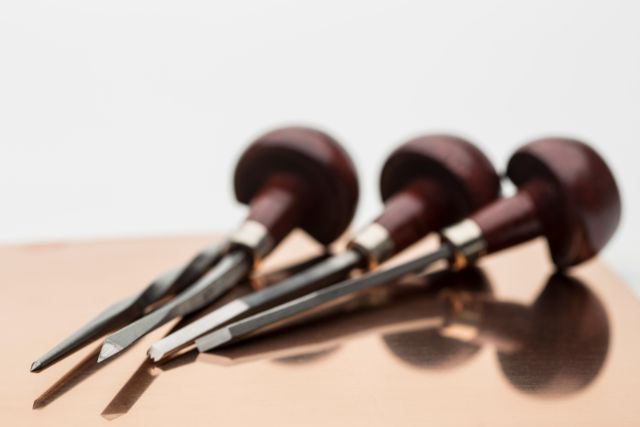
Dremel Tools
Dremel tools, with their various attachments, are used for intricate carving and engraving. These tools allow for detailed work that would be challenging with traditional tools alone.

Dremel 4300-5/40 Engraver, Sander, Polisher & More
Engrave your drinking horns with precision using the Dremel 45-Piece Kit. Lightweight, variable speed, and powerful motor ensure flawless, custom designs every time.
Bandsaws
Bandsaws are essential for cutting the horn into manageable pieces and trimming excess material.
They provide the precision needed to work with the unique shapes and sizes of each horn.
Sanders and Buffing Wheels
Sanding smooths the surface of the horn, removing imperfections, while buffing polishes it to a high gloss, enhancing the horn’s natural beauty.
Techniques for Preparing the Horn
Proper preparation of the horn is vital to ensure it is ready for carving and decoration.
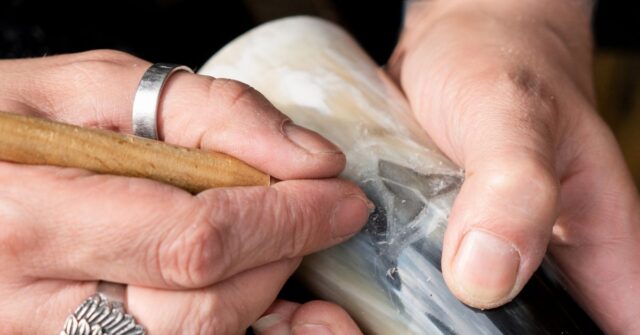
Cleaning and Sanitizing
The horn must be thoroughly cleaned and sanitized to remove any residues and bacteria.
This process typically involves soaking the horn in a mild soap solution and then rinsing it with clean water.
Shaping the Horn
Shaping the horn involves heating and molding it into the desired form.
Heating with Flames or Oil
Heating the horn makes it pliable. Craftsmen can use an open flame or hot oil to achieve this. The heat alters the horn’s fibers, making it soft and easy to mold.
Using Molds and Presses
Once heated, the horn is placed in molds or pressed to shape it. These molds can be custom-made to create specific designs and ensure consistency in the final product.
Carving and Decorating the Horn
Carving and decorating are where the horn transforms into a piece of art. This stage requires skill and creativity.
Transferring Designs to the Horn
Before carving begins, the design must be accurately transferred onto the horn.
Sketching and Stenciling
Designs can be sketched directly onto the horn or applied using stencils. This step ensures that the final carving will be precise and align with the artisan’s vision.
Carving Techniques
Carving the horn requires patience and a steady hand. Various techniques can be used depending on the complexity of the design.
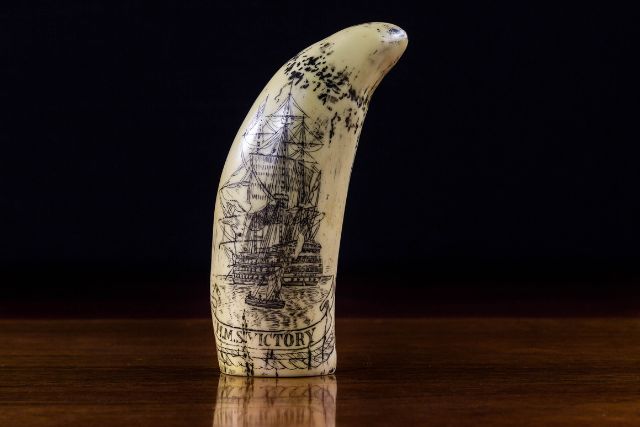
Basic vs. Intricate Designs
Beginners might start with simple patterns, gradually moving to more intricate designs as their skills improve. Detailed work often involves delicate tools and a high degree of concentration.
Engraving and Scrimshaw
Engraving and scrimshaw are traditional techniques that add intricate details to the horn.
Tools and Methods
Engraving tools or modern Dremel kits can be used for this purpose. Scrimshaw, which involves making small dots and lines, is particularly effective for creating detailed images and patterns.
Adding Embellishments
Embellishments enhance the aesthetic appeal of the drinking horn, making it unique and personal.
Inlays with Stones and Metals
Precious stones and metals can be inlaid into the horn to create stunning visual effects. This technique adds a layer of sophistication and individuality to each piece.
Attaching Metal Fittings
Metal fittings are often used to decorate the rim and tip of the horn. These fittings, made from materials like bronze, silver, or gold, add durability and elegance to the horn.

Making the Horn Functional
To transform the horn from a decorative piece into a functional drinking vessel, several steps are necessary.
Creating the Mouthpiece
The mouthpiece must be shaped and smoothed for comfortable use.
Shaping and Smoothing
The opening of the horn is ground, sanded, and polished to ensure it is safe and comfortable for drinking.
The size of the opening can be adjusted based on the horn’s size and the user’s preference.
Sealing and Waterproofing
Sealing the horn is crucial to make it waterproof and safe for drinking.
Using Beeswax
Traditionally, beeswax is used to coat the interior of the horn. This natural sealant is safe for food and helps preserve the horn’s integrity.
Applying Epoxy Resin
Modern artisans often use food-safe epoxy resin to seal the horn. This method provides a durable, long-lasting seal that prevents leaks and ensures the horn is hygienic.

8 Ounce Food Safe Epoxy Resin Kit
Create a rock solid seal for your drinking horn. Crystal clear, non-toxic, UV resistant, and easy to mix. Your horn will be able to handle hot liquids after sealing.
Finishing Touches
The final touches enhance the horn’s appearance and functionality, turning it into a true work of art.
Polishing the Horn
Polishing brings out the natural beauty of the horn.
Using Non-toxic Polishes
A soft cloth and non-toxic polish are used to buff the horn, giving it a shiny, smooth finish. This step highlights the horn’s natural patterns and colors.
Adding Straps and Holders
Straps and holders make the horn more practical and easier to use.
Leather Straps
Leather straps can be attached to the horn for easy carrying. They also add a rustic, authentic touch to the piece.
Metal Holders
Metal holders provide a sturdy base for displaying the horn. They are often decorated to complement the horn’s design.
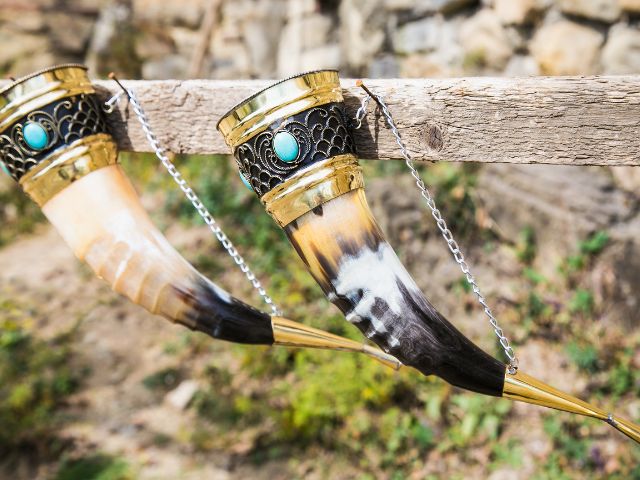
Maintaining and Caring for Your Drinking Horn
Proper care and maintenance will ensure your drinking horn remains in excellent condition for many years.
Following these guidelines will help you preserve both the functionality and beauty of your horn.
Cleaning Techniques
Regular cleaning is essential to keep your drinking horn hygienic and looking its best.
Hand Washing
Always hand wash your drinking horn with mild soap and warm water. Avoid using harsh detergents, which can damage the horn and its sealant.
Gently scrub the interior and exterior, then rinse thoroughly.
Avoiding Dishwashers
Dishwashers should be avoided as the high heat and strong detergents can cause the horn to warp and the sealant to degrade.
Hand washing is the best method to maintain your horn’s integrity.
Storage Tips
Proper storage is crucial to prevent damage and ensure the longevity of your drinking horn.
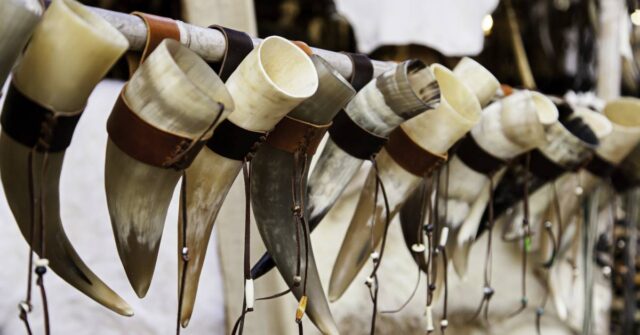
Keeping in a Cool, Dry Place
Store your horn in a cool, dry place away from direct sunlight. Excessive heat and moisture can cause the horn to crack or warp.
A well-ventilated area is ideal for preventing mold and mildew growth.
Using Stands for Display and Protection
Using a stand not only showcases your drinking horn beautifully but also protects it from accidental damage.
A stand keeps the horn upright, preventing it from rolling and potentially falling.
Repair and Restoration
Over time, your drinking horn may need some repairs to maintain its functionality and appearance.
Fixing Chips and Cracks
If your horn develops chips or cracks, these can often be repaired with food-safe epoxy. Apply the epoxy to the damaged area, smooth it out, and allow it to cure completely.
For significant damage, it’s best to consult a professional craftsman.
Re-sealing the Interior
Re-sealing the interior of your horn may be necessary if the original sealant begins to wear off.
Clean the interior thoroughly, then reapply beeswax or epoxy resin as needed to maintain a safe, waterproof barrier.
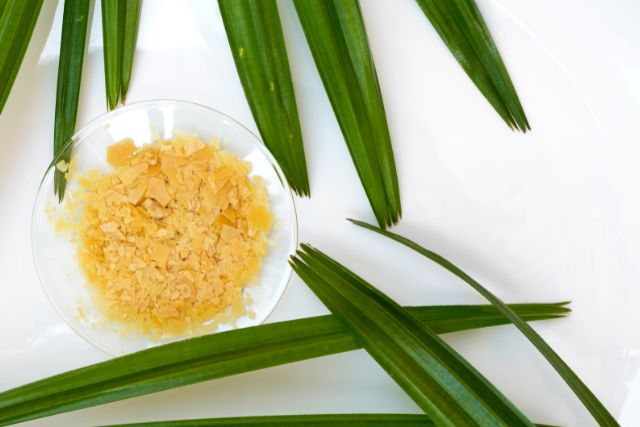
Appreciating the Art of Drinking Horns
Beyond their practical use, drinking horns are cherished for their artistic and historical value. Understanding this art can deepen your appreciation for these unique items.
Famous Drinking Horn Carvings
Throughout history, many drinking horns have stood out for their intricate carvings and cultural significance.
For example, the Anglo-Saxon drinking horn from the Sutton Hoo burial site in England showcases elaborate designs that tell a story of ancient craftsmanship.
Displaying Your Drinking Horn
Displaying your drinking horn can be as rewarding as using it. Proper display methods protect the horn and allow you to showcase its beauty.
Display Stands
Display stands are a popular choice for showcasing drinking horns. These stands can be made from wood, metal, or other materials that complement the horn’s design.
They keep the horn secure and prominently displayed.
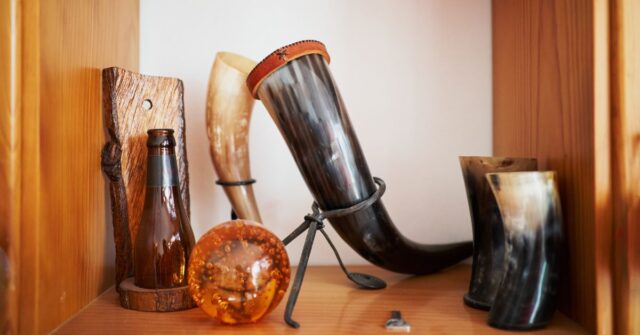
Wall Mounts
Wall mounts offer an alternative way to display your horn. They save space and create an eye-catching focal point in any room.
When mounting, ensure the horn is securely fastened to prevent accidents.
Conclusion
Crafting a drinking horn is a meticulous process that blends history, tradition, and artistry.
From selecting the right materials to applying the finishing touches, each step requires skill and patience.
Whether you’re an artisan, a collector, or simply an admirer, understanding the intricacies of this craft allows you to appreciate each drinking horn as a unique piece of art.
Summary of Craftsmanship Techniques
We’ve explored the journey of a drinking horn from raw material to a finished product.
Key steps include cleaning and shaping the horn, carving and decorating it with intricate designs, and making it functional through proper sealing and finishing touches.
The Cultural and Personal Value of Drinking Horns
Drinking horns are not just functional items; they are cultural artifacts that carry stories from the past.
Owning a drinking horn connects you to ancient traditions and showcases your appreciation for fine craftsmanship.
Whether used in celebrations, displayed as art, or cherished as collectibles, drinking horns remain a testament to human creativity and heritage.
